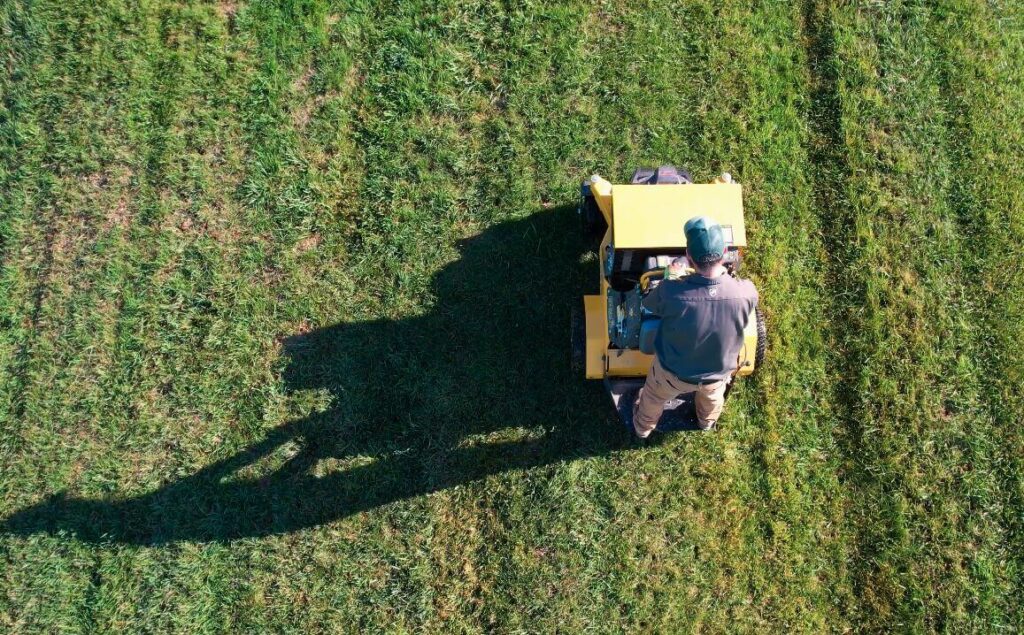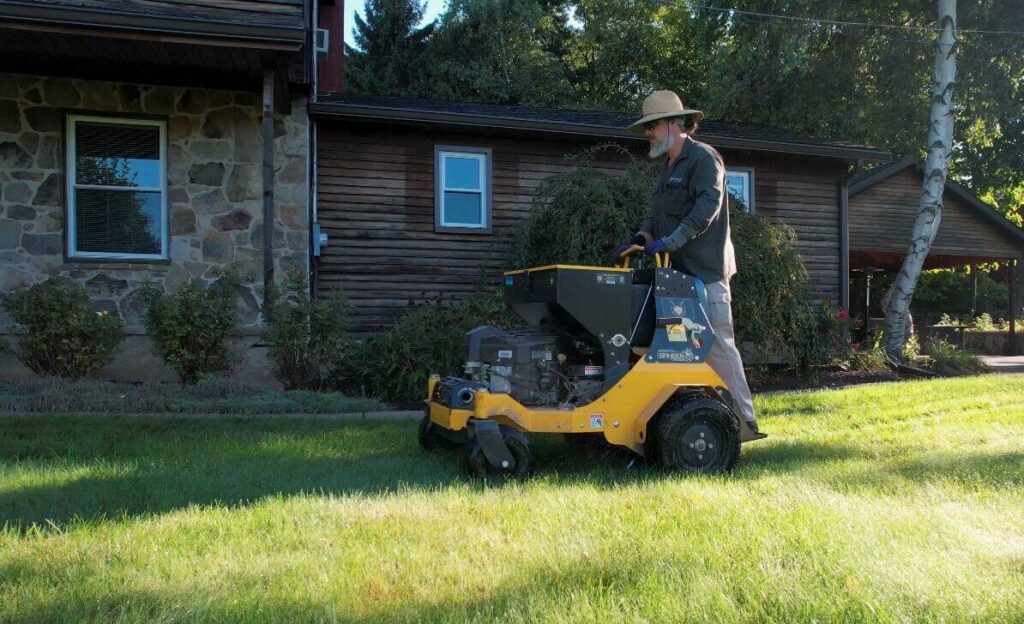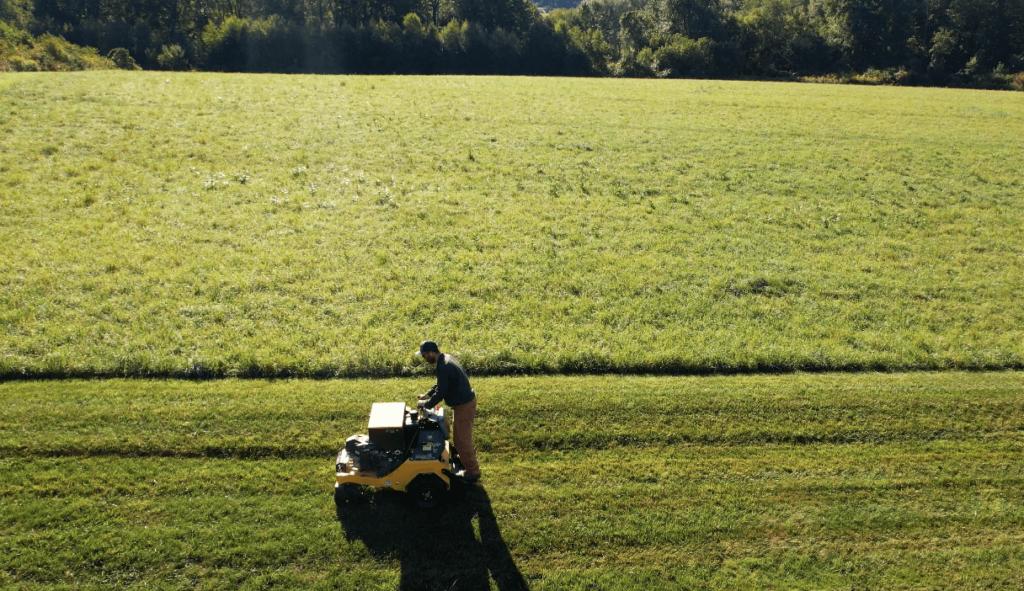Transform your lawn into a vibrant oasis with Turfcor Lawn & Tree Care's specialized Aeration & Overseeding services. Our skilled technicians enhance soil health and encourage lush growth, ensuring your outdoor space thrives. Schedule a consultation today to experience the beauty of a revitalized landscape.
Maintaining a healthy lawn requires more than just watering and mowing on a regular basis. Proper timing is crucial and one effective approach that needs to be timed correctly is when to aerate and overseed your lawn. This guide explains when to aerate and overseed based on the seasons and how they affect seed germination and grass growth.
Discover why late summer and early fall are ideal for these activities, particularly for cool-season grasses. Understanding the timing can assist in achieving a vibrant, flourishing lawn. By understanding the science behind this timing, you can maximize your lawn’s potential and achieve the lush, green turf you’ve always dreamed of.
Why Timing is the Key to Aeration and Overseeding
Aeration and overseeding are essential components of any seasonal lawn strategy. Timing is key when it comes to promoting optimal growth. Understanding the science behind soil aeration and seed germination is critical to ensuring a lush and healthy lawn. Soil aeration is necessary to facilitate healthy root systems, as it allows for better nutrient and water absorption.
and healthy lawn. Soil aeration is necessary to facilitate healthy root systems, as it allows for better nutrient and water absorption.
Germination success relies on several factors, including seed-to-soil contact, temperature, moisture, and sunlight. By synchronizing aeration and overseeding, you can enhance seed-to-soil contact, increasing the likelihood of successful germination. Timing also plays a significant role in nutrient availability and uptake for emerging seedlings. So, plan your aeration and overseeding schedule carefully and reap the rewards of a thriving lawn.
Late Summer and Early Fall: The Prime Time for Aeration and Overseeding
Late summer and early fall are key times for aerating and overseeding your lawn. During this period, a combination of factors creates an ideal environment for lawn rejuvenation. As summer heat begins to wane and cooler temperatures start to emerge, your lawn undergoes a transition that sets the stage for remarkable growth.
During this period, cooler soil temperatures play a pivotal role in unlocking the dormancy of seeds, prompting them to sprout and establish robust root systems. This synergy between temperature moderation and seed vitality is a crucial catalyst for optimal germination rates. Additionally, the reduced competition from summer weeds further amplifies the potential for successful overseeding.
By employing aeration and overseeding during this transition, you allow emerging seedlings to establish robust root networks that weather the imminent winter. These roots act as anchors, securing essential nutrients and water, which pave the way for an impressive resurgence come spring. Aligning your efforts with nature’s cues creates a harmonious interplay, resulting in a resilient and lush landscape.
Revitalize Your Lawn!
Step-by-Step Guide to Aeration and Overseeding in Late Summer/Early Fall:
 Achieving a thriving, rejuvenated lawn through aeration and overseeding during the late summer and early fall window requires a methodical approach. This step-by-step guide ensures that your efforts result in an effective and timely transformation.
Achieving a thriving, rejuvenated lawn through aeration and overseeding during the late summer and early fall window requires a methodical approach. This step-by-step guide ensures that your efforts result in an effective and timely transformation.
Lawn Assessment:
Conduct a comprehensive assessment of your lawn’s condition. Identify areas marred by compacted soil, bare patches, and thinning grass. This scrutiny equips you with a clear roadmap for targeting areas in need of aeration and overseeding.
Aeration Techniques:
When deciding between core aeration and slice seeding, core aeration stands out as the top choice. This method goes deeper into your lawn’s soil, relieving compacted areas by removing small plugs. This allows air, water, and nutrients to reach the grassroots, which is crucial for healthy growth. Core aeration not only fixes current issues but also sets the stage for long-term health. On the other hand, slice seeding, while effective, may not offer the same comprehensive benefits as core aeration. By going with core aeration, you create the ideal conditions for seeds to connect with the soil, leading to stronger growth and a more vibrant lawn.
Seed Selection:
Optimal seed selection is paramount. Research and select cool-season grass varieties that are well-suited to your region’s climate. This informed decision sets the stage for robust growth and resilience against local conditions.
Overseeding Process:
Perform overseeding carefully. Ensure even distribution of seeds in targeted areas and follow recommended depths for better germination. Pay close attention to detail, as this precision sets the foundation for consistent growth.
Post-Overseeding Care:
Post-overseeding care is a nurturing commitment that demands your vigilance. Craft a watering schedule that keeps the soil consistently moist but not waterlogged. Implement a balanced fertilizer regimen that fuels emerging seedlings without overwhelming them. Regularly monitor germination progress, making adjustments as needed to support healthy growth.
Navigating this comprehensive guide empowers you to traverse the intricate terrain of aeration and overseeding with precision and confidence. By harmonizing the science behind timing with the practical intricacies of implementation, you set your lawn on a trajectory toward opulent growth and enduring vitality.
Cultivating a Lush Lawn Through Strategic Timing
 Improved lawn health and aesthetics aren’t solely a matter of consistent tending – the timing of your lawn care practices is just as important. Aeration and overseeding are processes that require thoughtful consideration of environmental constraints, emphasizing the value in aligning your efforts with seasonal rhythms. Nature works in harmony to create optimum growing conditions, presenting late summer and early fall as the ideal time for lawn rejuvenation. By taking advantage of the environmental benefits afforded by this season, you can expect a lush landscape that exudes vibrancy and vitality.
Improved lawn health and aesthetics aren’t solely a matter of consistent tending – the timing of your lawn care practices is just as important. Aeration and overseeding are processes that require thoughtful consideration of environmental constraints, emphasizing the value in aligning your efforts with seasonal rhythms. Nature works in harmony to create optimum growing conditions, presenting late summer and early fall as the ideal time for lawn rejuvenation. By taking advantage of the environmental benefits afforded by this season, you can expect a lush landscape that exudes vibrancy and vitality.
For truly beautiful results, trust Turfcor Lawn and Tree Care to provide both exceptional services and knowledgeable guidance when it comes to aeration and overseeding. Let us join you on your journey towards an inviting outdoor space with superior landscaping knowledge and stellar customer service at your disposal! Why wait? Contact us today to get started on transforming your lawn into a picture-perfect paradise.
Before aeration and overseeding, it’s important to clearly mark the location of your irrigation system components, such as sprinkler heads and buried pipes. This will help the lawn care team avoid damaging them during the process. You can use small flags or stakes to mark the precise locations of these components. Communicate with the lawn care professionals about the irrigation system’s layout so they can work around it safely.
Yes, it’s recommended to mark the boundaries of your invisible dog fence as well. This ensures that the lawn care team is aware of its location and can avoid disrupting or damaging the fence during aeration and overseeding. Just like with the irrigation system, use flags or stakes to clearly mark the perimeter of the invisible dog fence.
In addition to marking your irrigation system and invisible dog fence, you should mark any other potential obstacles or sensitive areas in your lawn. This could include garden beds, delicate plants, pathways, or any other features you want to protect during the aeration and overseeding process.
Ideally, it’s best to remove leaves from your lawn before aeration and overseeding. Leaves can create a barrier that prevents the seeds from making direct contact with the soil, potentially hindering germination and growth. Clearing the leaves will help ensure the best results. If leaves are present, you might want to consider having them cleared before the aeration and overseeding process.
Yes, proper watering is crucial after aeration and overseeding. The newly aerated soil provides an excellent environment for seed germination, but it also means that the soil can dry out more quickly. Keep the seeded area consistently moist, not soggy, by watering lightly and frequently. Follow the recommendations provided by your lawn care professional to ensure the right watering schedule for your specific situation.
It’s recommended to mow your lawn slightly shorter than usual before aeration and overseeding. This helps the overseeding process by allowing the seeds to come into better contact with the soil. However, after overseeding, avoid mowing the newly seeded areas until the grass has established itself and reached a height of at least 3 inches. This might take a few weeks, so be patient and allow the new grass to develop a strong root system before mowing.